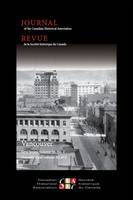- EAN13
- 9780887983153
- Éditeur
- Journal of the Canadian Historical Association
- Langue
- français
- Fiches UNIMARC
- S'identifier
Journal of the Canadian Historical Association Revue de la Société historique du Canada Volume 30, numéro 2, 2019
Jason Ellis, Elyse Bell, Michael Borsk, Anna Tible, Barbara M. Freeman, Frank A. Abbott
Journal of the Canadian Historical Association
Livre numérique
-
Aide EAN13 : 9780887983153
- Fichier EPUB, avec Marquage en filigrane
13.99
This article examines public school taxes, housing, and changing suburban
space in Etobicoke Township (suburban Toronto) between 1945 and 1954. Bridging
educational and urban and suburban history, and incorporating recent insights
from tax history, it examines the role that school taxes played in
transforming Etobicoke from a rural and income-mixed pre-war suburb into a
more middle-class, homogenous post-war one. School trustees taxed the new,
middle-class housing being constructed in the suburb to underwrite educational
expenditures that expanded and modernized the Etobicoke public school system.
At the same time, tax and other public policy excluded lower-value rental
housing and small dwellings, and also excluded their residents, who did not
contribute enough in property taxes to support the emerging suburban school
system. School taxes marked inclusion and exclusion in changing Etobicoke. As
suburban space changed, established working-class residents and farmers tried
to defend their interests as school taxpayers. Farmers could not defend their
interests in the same way, and many sold their properties to sub-dividers for
housing, erasing farms and one-room schools from the suburban landscape. The
history of suburbanization and the history of educational expansion and
modernization were causatively dependent on one another. Historians of
education and urban and suburban historians benefit from drawing on each
other’s aligned historiographies, and from looking at taxes.
space in Etobicoke Township (suburban Toronto) between 1945 and 1954. Bridging
educational and urban and suburban history, and incorporating recent insights
from tax history, it examines the role that school taxes played in
transforming Etobicoke from a rural and income-mixed pre-war suburb into a
more middle-class, homogenous post-war one. School trustees taxed the new,
middle-class housing being constructed in the suburb to underwrite educational
expenditures that expanded and modernized the Etobicoke public school system.
At the same time, tax and other public policy excluded lower-value rental
housing and small dwellings, and also excluded their residents, who did not
contribute enough in property taxes to support the emerging suburban school
system. School taxes marked inclusion and exclusion in changing Etobicoke. As
suburban space changed, established working-class residents and farmers tried
to defend their interests as school taxpayers. Farmers could not defend their
interests in the same way, and many sold their properties to sub-dividers for
housing, erasing farms and one-room schools from the suburban landscape. The
history of suburbanization and the history of educational expansion and
modernization were causatively dependent on one another. Historians of
education and urban and suburban historians benefit from drawing on each
other’s aligned historiographies, and from looking at taxes.
S'identifier pour envoyer des commentaires.

